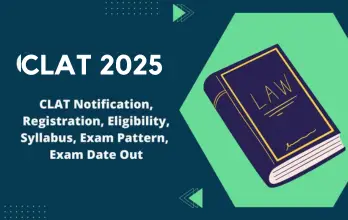CLAT is one of the most competitive law entrance exams and it requires careful planning and strategic preparation to ace this exam. Just as a skilled navigator studies the map before beginning a challenging journey, understanding the CLAT exam is extremely important to sail through it. This article aims to equip you with valuable insights and practical tips to not only understand the exam structure but also develop an effective roadmap for your preparation.
CLAT or Common Law Admission Test is a national-level entrance examination conducted by the Consortium of National Law Universities for admissions to undergraduate (“UG”) and postgraduate (“PG”) law programmes offered by 22 National Law Universities in India (NLUs). CLAT is mainly taken by those aspirants who want to pursue their career in Law as this exam offers you the opportunity to secure a seat in the top National Law Universities of the country.
Regarded as one of the toughest entrance examinations in India, the acceptance rate stands exceptionally low at a mere 3 percent. This test is taken after the Higher Secondary Examination or the 12th grade for admission to an integrated undergraduate degree in Law (BA/BBA/B.COM/B.SC/BSW LLB) and after Graduation in Law for Master of Laws (LL.M) programs offered by these law schools.
By knowing the examination format, structure, and syllabus, you can plan your study schedule effectively, allocate time appropriately, and focus on the relevant topics. Additionally, having a clear idea of the purpose of attempting that particular exam provides a clear sense of direction and keeps you focused on your goals & serves as a source of inspiration during challenging times.
Like an early bird that catches the worm, starting early in your CLAT exam preparation gives you the coveted advantage that sets you apart from your competitors. Beginning your CLAT preparation well in advance, even before completing your 12th standard, shall grant you the crucial edge required to crack this exam.
By starting early, you have a longer timeframe to cover the extensive syllabus of CLAT and build a solid foundation of knowledge and skills that are necessary to crack this highly competitive law entrance exam.
A strategic study plan developed according to your strengths and weaknesses holds the capacity to double your score in the exam and secure admission to your dream National Law University. Create a study timetable and adhere to it consistently
While developing a study plan, you must encompass the following to get the best results:
• Attempt Previous Year Papers: This should be the first step of your preparation. By attempting the previous year's CLAT mock tests, you can effectively determine your current position and familiarize yourself with the types of questions asked in the CLAT exam.
Click here to attempt CLAT Previous year mock test now!
• Build your foundation: After gaining a fair idea of your current level of preparedness, it is recommended that you take note of the topics where you encountered the most difficulty and strengthen those topics from scratch with the help of the video lectures on our YouTube channel “LawEx by Smartkeeda”.
• Strengthen weak Topics: After understanding a particular topic through video lectures, immediately attempt CLAT topic tests to validate your knowledge and understanding of that topic. This targeted approach allows you to strengthen weak areas and gain mastery over your weak topics.
You can attempt CLAT Topic Tests here!
• Improve Reading Skills: CLAT examination comprises passage-based questions, making strong reading and comprehension skills extremely essential. Include reading practice material such as newspapers, magazines, and relevant articles to enhance reading comprehension skills, broaden general knowledge, and improve understanding of complex passages.
• Vocabulary Drills: Dedicate time to expanding your general and legal vocabulary by engaging in vocabulary drills, learning new words, and practicing their usage in context. This will enhance your language skills and help you tackle the questions more effectively.
• Full-Length Mocks: These mock tests simulate actual exam conditions, and help you track your overall progress. By attempting full-length mocks, you can improve your time management skills, and identify any remaining gaps in your knowledge.
You should try to attempt at least one full-length CLAT mock test every week to ensure that you are strengthening your weak areas and improving your performance with each attempt.
Attempt a CLAT free full-length mock test here!
• Revise and Review: Set aside regular time for revision and review of all subjects and topics covered. Revise concepts, formulas, and legal principles to ensure they are well understood and retained.
“Work hard, and you will earn good rewards. Work smart, and you will earn great rewards. Work hard and work smart, and you will earn extraordinary rewards.”
Integration of smart work with hard work is what leads to extraordinary results. Just blindly trying to cover the syllabus would not be efficient, you should try to approach it with strategic planning. To master the CLAT syllabus effectively, you should focus on the topics that carry the highest weightage.
For example, current affairs and general knowledge is one of the sections of the CLAT exam that carries the highest weightage. Approximately 35-39 questions, which make up around 25% of the paper, are asked from this section, allocating adequate time and resources to mastering current affairs will greatly enhance your overall performance.
You can understand the weightage of different subjects in CLAT 2025 from the following table:
Each subject holds its own significance and contributes to your overall performance in the exam. By distributing your study hours evenly across all subjects, you can provide proper focus to the key areas and ensure efficient coverage of the diverse topics and subtopics asked in CLAT.
CLAT is a time-bound exam and Speed and accuracy are of utmost importance when it comes to CLAT mock tests. Speed plays a vital role, particularly when faced with lengthy passages that require careful reading and comprehension.
While speed is crucial, maintaining accuracy is equally important as there is a negative marking of 0.25 for each incorrect answer. Therefore, good accuracy as it ensures that your answers are correct and reflect your understanding of the questions. Striking the right balance between speed and accuracy is key to cracking the CLAT exam.
To achieve speed and accuracy in your, CLAT mock tests prove to be an excellent tool. The mock tests closely simulate the actual exam environment, enabling you to practice under realistic conditions. By regularly attempting the mock tests you can familiarize yourself with the most effective strategies that may save you time. Let us understand the steps to enhance your speed and accuracy through mock tests:
Attempt a full-length CLAT mock test at Smartkeeda and try to complete it in a go without halting. After completing the mock test, move to “Smart Analysis” and move to the “Time Management” tab.
In this section, you can get a clear idea of the topics that consumed most of your time. Here your time spent on correct, incorrect, and skipped questions is displayed in a graphical format. Also, your spent time is compared to the toppers.
While looking deep into your time management part, you should be able to respond to the following queries:
• Which questions consumed a lot of time?
• Which questions were attempted within seconds by the topper?
• In how many questions did you take more than average time?
• To save time, which questions should be approached first?
• What proportion of time should be assigned to each type of question?
Move to the “Speed & Accuracy” tab and notice the number of questions attempted by you in the first, second, third, and the last quarter and compare these stats to the topper. In the accuracy slot, check the number of questions accurately marked by you and get it compared with the topper’s attempts.
After getting a note of the topics and questions where you spend more than average time, go through the explanation part and learn better techniques to solve those questions. You can also review those time-consuming topics through the video lectures at the LawEx YouTube channel to build your understanding of those topics from scratch.
After strengthening your concepts through video lectures and working on your time-consuming topics, reattempt the full-length test and track your overall progress. You should use the "My Performance Graph" feature to assess your improvement and identify any remaining gaps in your knowledge.
By regularly taking these mock tests, you can effectively enhance your speed, accuracy, and time-management skills.
In the CLAT exam, the questions in Mathematics and Numerical Ability are typically of easy to moderate difficulty level. However, scoring well in this section can provide you with a significant advantage over other aspirants. A strong performance in this section can help boost your overall score and increase your chances of securing a higher rank in the CLAT exam.
The Quantitative Techniques section of the UG-CLAT 2025 would test your skills related to an empirical inquiry via mathematical, statistical, or computational data gathering and analysis. Here are some tips to excel in the Mathematics and Numerical Ability of CLAT:
In the Logical Reasoning section of the UG CLAT 2025, you would be presented with a series of short passages of about 300 words each. The purpose of CLAT logical reasoning is to assess logical reasoning ability using the information provided in the passage. Here are some tips that can help you enhance your logical reasoning abilities for CLAT 2025:
All the aforementioned tips and strategies would be useless if you are unable to retain the information. No matter how well you understand the concepts, if you cannot retain the information, it would become challenging to perform well in the exam. Therefore, it is essential to prioritize retention strategies alongside other study methods.
Here are some effective retention techniques that you can adopt to boost your ability to remember and recall information during exams.
Finally, it is essential to remain calm and consistent in your preparation, dedicating the required time and effort to each subject. Remember, the right preparation accompanied by the right attitude is the key to achieving a favorable position in the field of law. Stay focused, stay determined, and let your hard work pave the way for a successful journey in the CLAT exam and beyond.
1. Understanding the CLAT Exam
CLAT or Common Law Admission Test is a national-level entrance examination conducted by the Consortium of National Law Universities for admissions to undergraduate (“UG”) and postgraduate (“PG”) law programmes offered by 22 National Law Universities in India (NLUs). CLAT is mainly taken by those aspirants who want to pursue their career in Law as this exam offers you the opportunity to secure a seat in the top National Law Universities of the country.
Regarded as one of the toughest entrance examinations in India, the acceptance rate stands exceptionally low at a mere 3 percent. This test is taken after the Higher Secondary Examination or the 12th grade for admission to an integrated undergraduate degree in Law (BA/BBA/B.COM/B.SC/BSW LLB) and after Graduation in Law for Master of Laws (LL.M) programs offered by these law schools.
CLAT Exam Overview
| Features |
UG Programme (5-year integrated Ll.B.) |
| Mode of Exam | Offline |
| Duration | 2 Hours |
| Question Format | Multiple Choice Questions (MCQ) |
| Maximum Questions | 150 Questions |
| Maximum Marks | 150 Marks |
| Subjects | English Language, and Current Affairs including General Knowledge, Legal Reasoning, Logical Reasoning, and Quantitative Techniques. |
| Frequency of Exam | Once a year |
| Medium of Exam | English |
| Exam date | December 2024 |
| Negative Marking Scheme | Yes (-0.25 marks for every wrong answer) |
By knowing the examination format, structure, and syllabus, you can plan your study schedule effectively, allocate time appropriately, and focus on the relevant topics. Additionally, having a clear idea of the purpose of attempting that particular exam provides a clear sense of direction and keeps you focused on your goals & serves as a source of inspiration during challenging times.
2. Start Early: Developing a Strategic Study Plan
Like an early bird that catches the worm, starting early in your CLAT exam preparation gives you the coveted advantage that sets you apart from your competitors. Beginning your CLAT preparation well in advance, even before completing your 12th standard, shall grant you the crucial edge required to crack this exam.
By starting early, you have a longer timeframe to cover the extensive syllabus of CLAT and build a solid foundation of knowledge and skills that are necessary to crack this highly competitive law entrance exam.
A strategic study plan developed according to your strengths and weaknesses holds the capacity to double your score in the exam and secure admission to your dream National Law University. Create a study timetable and adhere to it consistently
While developing a study plan, you must encompass the following to get the best results:
• Attempt Previous Year Papers: This should be the first step of your preparation. By attempting the previous year's CLAT mock tests, you can effectively determine your current position and familiarize yourself with the types of questions asked in the CLAT exam.
Click here to attempt CLAT Previous year mock test now!
• Build your foundation: After gaining a fair idea of your current level of preparedness, it is recommended that you take note of the topics where you encountered the most difficulty and strengthen those topics from scratch with the help of the video lectures on our YouTube channel “LawEx by Smartkeeda”.
• Strengthen weak Topics: After understanding a particular topic through video lectures, immediately attempt CLAT topic tests to validate your knowledge and understanding of that topic. This targeted approach allows you to strengthen weak areas and gain mastery over your weak topics.
You can attempt CLAT Topic Tests here!
• Improve Reading Skills: CLAT examination comprises passage-based questions, making strong reading and comprehension skills extremely essential. Include reading practice material such as newspapers, magazines, and relevant articles to enhance reading comprehension skills, broaden general knowledge, and improve understanding of complex passages.
• Vocabulary Drills: Dedicate time to expanding your general and legal vocabulary by engaging in vocabulary drills, learning new words, and practicing their usage in context. This will enhance your language skills and help you tackle the questions more effectively.
• Full-Length Mocks: These mock tests simulate actual exam conditions, and help you track your overall progress. By attempting full-length mocks, you can improve your time management skills, and identify any remaining gaps in your knowledge.
You should try to attempt at least one full-length CLAT mock test every week to ensure that you are strengthening your weak areas and improving your performance with each attempt.
Attempt a CLAT free full-length mock test here!
• Revise and Review: Set aside regular time for revision and review of all subjects and topics covered. Revise concepts, formulas, and legal principles to ensure they are well understood and retained.
3. Mastering the CLAT Syllabus: Focus on Key Areas
“Work hard, and you will earn good rewards. Work smart, and you will earn great rewards. Work hard and work smart, and you will earn extraordinary rewards.”
Integration of smart work with hard work is what leads to extraordinary results. Just blindly trying to cover the syllabus would not be efficient, you should try to approach it with strategic planning. To master the CLAT syllabus effectively, you should focus on the topics that carry the highest weightage.
For example, current affairs and general knowledge is one of the sections of the CLAT exam that carries the highest weightage. Approximately 35-39 questions, which make up around 25% of the paper, are asked from this section, allocating adequate time and resources to mastering current affairs will greatly enhance your overall performance.
You can understand the weightage of different subjects in CLAT 2025 from the following table:
| Section | Number of Questions | Weightage |
| English Language | 28-32 Questions | 20% |
| GK & Current Affairs | 35-39 Questions | 25% |
| Logical Reasoning | 28-32 Questions | 20% |
| Legal Reasoning | 35-39 Questions | 25% |
| Quantitative Techniques | 13-17 Questions | 10% |
| Total | 150 Questions | 100% |
Each subject holds its own significance and contributes to your overall performance in the exam. By distributing your study hours evenly across all subjects, you can provide proper focus to the key areas and ensure efficient coverage of the diverse topics and subtopics asked in CLAT.
4. Practicing Mock Tests: Enhancing Speed and Accuracy
CLAT is a time-bound exam and Speed and accuracy are of utmost importance when it comes to CLAT mock tests. Speed plays a vital role, particularly when faced with lengthy passages that require careful reading and comprehension.
While speed is crucial, maintaining accuracy is equally important as there is a negative marking of 0.25 for each incorrect answer. Therefore, good accuracy as it ensures that your answers are correct and reflect your understanding of the questions. Striking the right balance between speed and accuracy is key to cracking the CLAT exam.
To achieve speed and accuracy in your, CLAT mock tests prove to be an excellent tool. The mock tests closely simulate the actual exam environment, enabling you to practice under realistic conditions. By regularly attempting the mock tests you can familiarize yourself with the most effective strategies that may save you time. Let us understand the steps to enhance your speed and accuracy through mock tests:
Step 1: Attempt a full-length mock
Attempt a full-length CLAT mock test at Smartkeeda and try to complete it in a go without halting. After completing the mock test, move to “Smart Analysis” and move to the “Time Management” tab.
Step 2: Check Time management
In this section, you can get a clear idea of the topics that consumed most of your time. Here your time spent on correct, incorrect, and skipped questions is displayed in a graphical format. Also, your spent time is compared to the toppers.
While looking deep into your time management part, you should be able to respond to the following queries:
• Which questions consumed a lot of time?
• Which questions were attempted within seconds by the topper?
• In how many questions did you take more than average time?
• To save time, which questions should be approached first?
• What proportion of time should be assigned to each type of question?
Step 3: Check Speed & Accuracy
Move to the “Speed & Accuracy” tab and notice the number of questions attempted by you in the first, second, third, and the last quarter and compare these stats to the topper. In the accuracy slot, check the number of questions accurately marked by you and get it compared with the topper’s attempts.
Step 4: Learn Better Techniques
After getting a note of the topics and questions where you spend more than average time, go through the explanation part and learn better techniques to solve those questions. You can also review those time-consuming topics through the video lectures at the LawEx YouTube channel to build your understanding of those topics from scratch.
Step 5: Reattempt!
After strengthening your concepts through video lectures and working on your time-consuming topics, reattempt the full-length test and track your overall progress. You should use the "My Performance Graph" feature to assess your improvement and identify any remaining gaps in your knowledge.
By regularly taking these mock tests, you can effectively enhance your speed, accuracy, and time-management skills.
5. Strategies for Tackling Mathematics and Numerical Ability
In the CLAT exam, the questions in Mathematics and Numerical Ability are typically of easy to moderate difficulty level. However, scoring well in this section can provide you with a significant advantage over other aspirants. A strong performance in this section can help boost your overall score and increase your chances of securing a higher rank in the CLAT exam.
The Quantitative Techniques section of the UG-CLAT 2025 would test your skills related to an empirical inquiry via mathematical, statistical, or computational data gathering and analysis. Here are some tips to excel in the Mathematics and Numerical Ability of CLAT:
- To tackle questions from the Quantitative Techniques section, it is crucial to focus on building a strong foundation. If you find yourself lacking in conceptual clarity regarding certain topics, you can understand that topic from our top Law Faculty at LawEx coaching by Smartkeeda.
- A knowledge of short tricks will help you in having that extra edge over your competitors. You can devise your own short tricks while practicing which will certainly help you to save time and maximize your attempts in the CLAT exam.
- Attempt Topic Tests and Sectional Tests of Quantitative aptitude at Smartkeeda to validate your knowledge in this section.
- Try to reduce the use of pen and paper as much as possible and train your mind to mentally deal with the questions.
- Doing random calculations mentally during your preparation phase will help you to sharpen your mental calculation skills which will help you to save your calculation time.
- Learning squares from 1-30 and cubes from 1-20 will help you to improve your calculation speed and attempt more questions in the saved time.
6. Enhancing Logical Reasoning Abilities - Tips and Techniques
In the Logical Reasoning section of the UG CLAT 2025, you would be presented with a series of short passages of about 300 words each. The purpose of CLAT logical reasoning is to assess logical reasoning ability using the information provided in the passage. Here are some tips that can help you enhance your logical reasoning abilities for CLAT 2025:
- Attempt Sectional Tests: To enhance your logical reasoning abilities for CLAT, you should first start familiarizing yourself with the passage-based questions asked in the CLAT exam. For this, you can attempt CLAT logical reasoning sectional tests at Smartkeeda.
- Attempt Topic Tests: If you find yourself struggling with any particular topic of logical reasoning, you can practice it individually through logical reasoning topic tests.
- Attend Video Classes: At Smartkeeda, you can attend Logical Reasoning video classes for CLAT 2025. In our logical reasoning playlist, we have curated videos that would help you comprehend reasoning patterns from the passage-based logical reasoning questions and improve your reasoning & analytical skills for the CLAT exam.
7. Effective Revision Techniques: Maximizing Retention and Recall
All the aforementioned tips and strategies would be useless if you are unable to retain the information. No matter how well you understand the concepts, if you cannot retain the information, it would become challenging to perform well in the exam. Therefore, it is essential to prioritize retention strategies alongside other study methods.
Here are some effective retention techniques that you can adopt to boost your ability to remember and recall information during exams.
- Instead of cramming all the current affairs of an entire month into a single study session, it would be more effective to break them into manageable chunks. For example, you can dedicate specific study sessions to topics like international news, sports events, economic developments, or government policies.
- Utilize visual aids such as diagrams or images while understanding complex information. Visualizing concepts helps in better comprehension and retention.
- Another powerful technique for improving retention is to associate something you read with a mental image. As you read, try to visualize the information as if it were a scene from a movie or a picture in your mind. By associating the information with memorable mental images, you will be able to recall information more effectively
Finally, it is essential to remain calm and consistent in your preparation, dedicating the required time and effort to each subject. Remember, the right preparation accompanied by the right attitude is the key to achieving a favorable position in the field of law. Stay focused, stay determined, and let your hard work pave the way for a successful journey in the CLAT exam and beyond.

Author : Rohit Sharma
Hi, I am Rohit Sharma, the head of the Law exams vertical at Smartkeeda and an alumnus of NLU Punjab. Having successfully cleared the CLAT exam twice, I am currently engaged in teaching Legal Reasoning on the LawEx YouTube channel. Moreover, I contribute by writing blogs that are specifically tailored to the CLAT exams.





